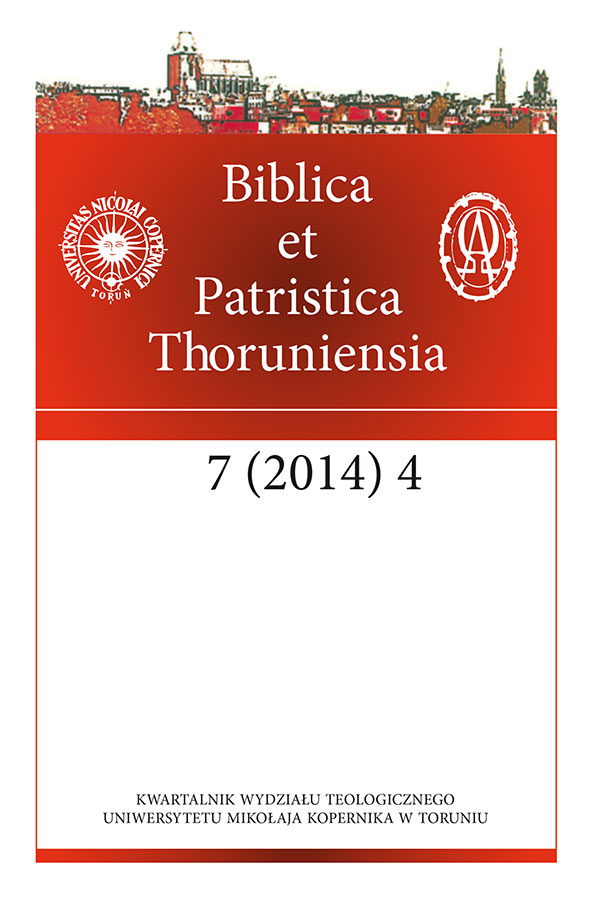Mk 1:1–3. A Later Addition to Mark’s Gospel?
DOI :
https://doi.org/10.12775/BPTh.2014.019Mots-clés
Mk 1, 1–3, the use of euangelion, textual affinity in the Gospels, OT citations in the NT, Oxyrhynchus 5073Résumé
In contrast to J.K. Elliot, N.C. Croy and other scholars who claim that “whatever was before Mk 1:4, it was not Mark 1:1–3,” it is argued in this research that such an opinion is not supported by the textual and linguistic evidence. Close analysis of the expressions and syntagms such as ἀρχή, εὐαγγέλιον Ἰησοῦ Χριστοῦ, καθὼς γέγραπται, κατασκευάσει, comparison between Mark 1:1–3 and Mark’s Gospel as well as comparison with Mt 11:10//Lk 7:27 show linguistic affinity between Mk 1:1–3 and that Gospel, other Synoptic Gospels and NT in general. Moreover, Papyrus Oxyrhynchus 5073, most probably the earliest textual witness to the beginning of Mark’s Gospel preserves Mk 1:1–2. Therefore, it seems that Mk 1:1–3 belongs to the same time and space as Mk 1:4ff.
Références
Aland K., Vollständige Konkordanz zum griechischen Neuen Testament, I-II (Berlin – New York: Walter de Gruyter, 1978-1983).
Arnold G., “Mk 1:1 und Eröffnungswendungen in griechischen und lateinischen Schriften,” ZNW 68 (1977) 123-127.
Boring M.E., “Mark 1:1-15 and the Beginning of the Gospel,” in D. Smith (ed.), How Gospels Begin (Semeia 52; Atlanta GA: Scholars Press, 1991) 185-192.
Buscemi M., “Critica textus di Mc 1,” in M. Adinolfi, P. Kaswalder (eds), Entrarono a Cafarnao (FS V. Ravanelli; SBF A 44; Jerusalem: Franciscan Printing Press, 1997) 73-80.
Cranfield C.E.B., The Gospel According to Saint Mark (Cambridge: Cambridge University Press, 1959).
Croy N.C., “Where the Gospel text begins. A non-theological interpretation of Mk 1:1,” NovT 43 (2001) 106-127.
Daniel R.W., “A Christian Amulet on Papyrus,” Vigiliae Christianae 37 (1983) 400-404.
Dautzenberg G., “Die Zeit des Evangeliums. Mk 1,1-15 und die Konzeption des Markusevangeliums,” Biblische Zeitschrift 22 (1978) 76-91.
Doudna J.Ch., The Greek of the Gospel of Mark (JBL Monograph Series, 12; Philadelphia: Society of Biblical Literature and Exegesis, 1961).
Elliot J.K., “Καθώς and ὣσπερ” in the New Testament,” Filologia Neotestamentaria 7 (1991) 55-58.
Elliott J.K., “Mark and the Teaching of Jesus: An Examination of ΛΟΓΟΣ and ΕΥΑΓΓΕΛΙΟΝ,” in W.L. Petersen, J.S. Vos, H.J. de Jonge (eds), Sayings of Jesus. Canonical and Non-Canonical. Essays in Honour of Tjitze Baarda (NovTSup 89; Leiden, 1997) 37-45.
Elliot J.K., “Mark 1.1–3 – A Later Addition to the Gospel?” NTS 46 (2000) 584-588.
France R.T., The Gospel of Mark. A Commentary on the Greek Text (New International Greek Testament Commentary; Grand Rapids, Mich, Carlisle; Eerdmans, Paternoster Press, 2002).
Guelich R.A., “‘The Beginning of the Gospel’ Mark 1:1-15,” BR 27 (1982) 5-15.
Haręzga S., Jezus i Jego uczniowie. Model Chrześcijańskiej formacji w Ewangelii św. Marka (Lublin: Wydawnictwo KUL, 2006).
Markus J., Mark 1-8 (The Anchor Bible; New York NY et al.: Doubleday, 2000).
Nestle E., “How Does the Gospel of Mark Begin,” The Expositor, vol. 4, 10 (1894) 458-460.
Pesch R., “Anfang des Evangeliums Jesu Christi. Eine Studie zum Prolog des Markusevangeliums (Mk 1,1-15), in Idem, Das Markus Evangelium (Darmstadt: Wissenschaftliche Buchgesellschaft, 1979) 311-355.
Preisendanz K. at al. (ed.), Papyri Graecae Magicae. Die Griechischen Zauberpapyri (Leipzig - Berlin: Teubner, 1931).
Smith G.S. – Bernhard A.E., “5073. Mark I 1-2: Amulet,” in D. Colomo – J. Chapa (ed.), Oxyrhynchus Papyri LXXVI (Graeco-Roman Memoirs 97; London: The Egyptian Exploration Society, 2011) 19-23.
Spitta F., “Beiträge zur Erklärung der Synoptiker,” ZNW 5 (1904) 303-326.
von Tischendorf C., Novum Testamentum Graece (8th ed.; 3 vols.; Lipsiae: Giesecke & Devrient, 1869-72).
Turner C.H., “Markan Usage: Notes, Critical and Exegetical, On the Second Gospel,” JTS 26 (1925) 145-156.
Way-Rider R., “The Lost Beginning of St. Mark’s Gospel,” in Studia Evangelica (Vol. 7; ed. Elizabeth A. Livingstone; Berlin: Akademie-Verlag, 1982) 553-556.
Wellhausen J., Das Evangelium Marci. Übersetzt und Erklärt (Berlin: Verlag von Georg Reimer, 1903).
Willker W., A Textual Commentary on the Greek Gospels, Vol. 2: Mark (Bremen, online published, 72010).
Téléchargements
Publiée
Comment citer
Numéro
Rubrique
Licence
CC BY ND 4.0. Posiadaczem prawa autorskiego (Licencjodawcą) jest Autor, który na mocy umowy licencyjnej udziela nieodpłatnie prawa do eksploatacji dzieła na polach wskazanych w umowie.
- Licencjodawca udziela Licencjobiorcy licencji niewyłącznej na korzystanie z Utworu/przedmiotu prawa pokrewnego w następujących polach eksploatacji: a) utrwalanie Utworu/przedmiotu prawa pokrewnego; b) reprodukowanie (zwielokrotnienie) Utworu/przedmiotu prawa pokrewnego drukiem i techniką cyfrową (e-book, audiobook); c) wprowadzania do obrotu egzemplarzy zwielokrotnionego Utworu/przedmiotu prawa pokrewnego; d) wprowadzenie Utworu/przedmiotu prawa pokrewnego do pamięci komputera; e) rozpowszechnianie utworu w wersji elektronicznej w formule open access na licencji Creative Commons (CC BY-ND 3.0) poprzez platformę cyfrową Wydawnictwa Naukowego UMK oraz repozytorium UMK.
- Korzystanie przez Licencjobiorcę z utrwalonego Utworu ww. polach nie jest ograniczone czasowo ilościowo i terytorialnie.
- Licencjodawca udziela Licencjobiorcy licencji do Utworu/przedmiotu prawa pokrewnego nieodpłatnie na czas nieokreślony
PEŁEN TEKST UMOWY LICENCYJNEJ >>
Stats
Number of views and downloads: 730
Number of citations: 0



